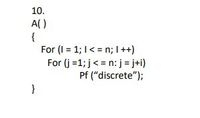
Database System Concepts
7th Edition
ISBN: 9780078022159
Author: Abraham Silberschatz Professor, Henry F. Korth, S. Sudarshan
Publisher: McGraw-Hill Education
expand_more
expand_more
format_list_bulleted
Concept explainers
Question

Transcribed Image Text:In questions 4-10 estimate the Big O value by analyzing the code. Note the algorithms are
written in English. Hint: you are interested in the number of operations for each algorithm.

Transcribed Image Text:10.
A()
{
For (I = 1; I< = n; 1++)
For (j =1; j< = n: j = j+i)
Pf ("discrete");
}
Expert Solution
This question has been solved!
Explore an expertly crafted, step-by-step solution for a thorough understanding of key concepts.
Step by stepSolved in 2 steps with 1 images

Knowledge Booster
Learn more about
Need a deep-dive on the concept behind this application? Look no further. Learn more about this topic, computer-science and related others by exploring similar questions and additional content below.Similar questions
- c++ programmingarrow_forwardint machineCompare1(struct machine* mac1, struct machine* mac2){ struct mac1; struct mac2; char make1[21], make2[21]; char model1[51], model2[21]; if((lap1 -> make1 == lap2 -> make2) && (lap1 -> model1 == lap2 -> model2)) return 0; else return 1;} have to create function to compare make and model of 2 machines - it's using structures - not sure if this is correct/ on the right track?arrow_forwardC++arrow_forward
- *Data Structuresarrow_forwardTopical Information Use C++. This lab will help you practice with dynamic memory (NOT mixed with classes). Program Information One statistic of interest to many researchers is the median of a set of data. The median is the value in the middle. (This is NOT the average, mind you.) Being in the middle, of course implies that the data are in order (sorted). If there are an odd number of data items, the middle is simple to find. If there are an even number of data items, you are supposed to take the average of the two middle values. You'll need to find the median of a set of data from a file. You don't know how many data are in the file, of course. You'll have to count the data, then read them in to sort, then find the median, and finally print it (the median) out. Do NOT use any more memory than is necessary!!arrow_forwardConsider the following C++ code segment: int d = 20; int f(int b) { static int c = 0; c *= b; return c; } int main() { int a; cin >> a; cout << f(a) * d << endl; }For each variable a, b, c, d: identify all type bindings and storage bindings for each binding, determine when the binding occurs identify the scope and lifetimearrow_forward
- ii) In JAVA language input the elements of an integer array A of size 10 and find the count of all hills in the array. A[i] is a Hill if A[i-1]A[i+1]. A[i] >= 0 All elements of the array are unique.arrow_forwardTopical Information Use C++. This lab will help you practice with dynamic memory (NOT mixed with classes). Program Information Heat flow through a rod can be simulated fairly easily in a computer program. We can simulate the rod using an array of temperatures. The rod begins all at the same temperature (user determined), but holding some position(s) of the rod at constant temperature (holding a match or ice cube to the rod) provides a [set of] heat source(s) (or sink(s)). To update the temperature at each time step (second?), you take the average of the positions on each side from the previous time step (and at the current position). For instance, if the following was the initial state of the rod: +------+------+------+------+------+------+------+------+ | 10 | 10 | 10 | 10 | 10 | 10 | 10 | 10 | +------+------+------+------+------+------+------+------+ And then the user specifies that there is a heat source at the left end of 100 degrees:…arrow_forward8.arrow_forward
- MULTIPLE FUNCTIONS AND RECURSIVE FUNCTIONS HANDS-ON use #include<stdio.h>arrow_forwardint getMax(int arr[], int n) { intmx=arr[0]; for (inti=1; i<n; i++) if (arr[i] >mx) mx=arr[i]; returnmx; } Can u give me the code for this one as well....this is the first function and countsort is the secondarrow_forward
arrow_back_ios
arrow_forward_ios
Recommended textbooks for you
 Database System ConceptsComputer ScienceISBN:9780078022159Author:Abraham Silberschatz Professor, Henry F. Korth, S. SudarshanPublisher:McGraw-Hill Education
Database System ConceptsComputer ScienceISBN:9780078022159Author:Abraham Silberschatz Professor, Henry F. Korth, S. SudarshanPublisher:McGraw-Hill Education Starting Out with Python (4th Edition)Computer ScienceISBN:9780134444321Author:Tony GaddisPublisher:PEARSON
Starting Out with Python (4th Edition)Computer ScienceISBN:9780134444321Author:Tony GaddisPublisher:PEARSON Digital Fundamentals (11th Edition)Computer ScienceISBN:9780132737968Author:Thomas L. FloydPublisher:PEARSON
Digital Fundamentals (11th Edition)Computer ScienceISBN:9780132737968Author:Thomas L. FloydPublisher:PEARSON C How to Program (8th Edition)Computer ScienceISBN:9780133976892Author:Paul J. Deitel, Harvey DeitelPublisher:PEARSON
C How to Program (8th Edition)Computer ScienceISBN:9780133976892Author:Paul J. Deitel, Harvey DeitelPublisher:PEARSON Database Systems: Design, Implementation, & Manag...Computer ScienceISBN:9781337627900Author:Carlos Coronel, Steven MorrisPublisher:Cengage Learning
Database Systems: Design, Implementation, & Manag...Computer ScienceISBN:9781337627900Author:Carlos Coronel, Steven MorrisPublisher:Cengage Learning Programmable Logic ControllersComputer ScienceISBN:9780073373843Author:Frank D. PetruzellaPublisher:McGraw-Hill Education
Programmable Logic ControllersComputer ScienceISBN:9780073373843Author:Frank D. PetruzellaPublisher:McGraw-Hill Education

Database System Concepts
Computer Science
ISBN:9780078022159
Author:Abraham Silberschatz Professor, Henry F. Korth, S. Sudarshan
Publisher:McGraw-Hill Education

Starting Out with Python (4th Edition)
Computer Science
ISBN:9780134444321
Author:Tony Gaddis
Publisher:PEARSON

Digital Fundamentals (11th Edition)
Computer Science
ISBN:9780132737968
Author:Thomas L. Floyd
Publisher:PEARSON

C How to Program (8th Edition)
Computer Science
ISBN:9780133976892
Author:Paul J. Deitel, Harvey Deitel
Publisher:PEARSON

Database Systems: Design, Implementation, & Manag...
Computer Science
ISBN:9781337627900
Author:Carlos Coronel, Steven Morris
Publisher:Cengage Learning

Programmable Logic Controllers
Computer Science
ISBN:9780073373843
Author:Frank D. Petruzella
Publisher:McGraw-Hill Education